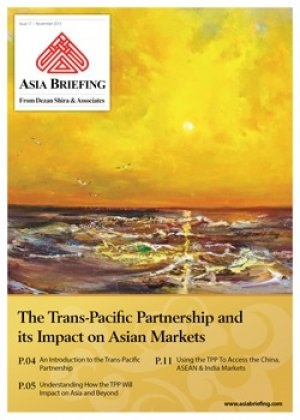The Philippines Export Development Plan: Addressing Obstacles to Trade

By: Dezan Shira & Associates
Editor: George Llewellyn-Jones
Seeking to maximize its position within ASEAN and make up for poor economic performance in recent quarters, the Philippines has implemented stimulus measures aimed at readjusting its export sector. The most significant actions that have been implemented or planned to date are outlined in the recently passed Philippine Export Development Plan (PEDP). For those currently considering the Philippines as a destination for foreign investment, the success of reforms will likely play a significant role in the island nation’s business landscape in the coming months.
Lagging Economic Growth as an Impetus for Reform
A significant catalyst behind the island nation’s drive for reform stems from lagging economic conditions found within the country. In addition to GDP growth slowing to 5.8 percent in 2015 – a far cry from the government’s 8 percent target – exports have also posted significant declines. January 2016 alone saw sales to overseas markets fall 3.9 percent compared to a year prior.
The slowdown in exports and its downstream impact on economic growth has largely come as a result of lagging international consumption and reduced demand on the part of China – the region’s main consumer. Recently however, concerns have also been raised by the Joint Foreign Chambers of the Philippines over exaggerated regulation of foreign investment. Both the Joint Foreign Chamber and PEDP highlight over-regulation as a critical impediment to achieving optimal export diversification.
 RELATED: Pre Investment and Market Entry Advisory from Dezan Shira & Associates
RELATED: Pre Investment and Market Entry Advisory from Dezan Shira & Associates
With prevalent economic conditions set to continue for some time, the Philippines has increasingly found itself under pressure from its ASEAN counterparts – many of whom are making significant gains in comparable export sectors. To address this issue, the Philippine Export Development Plan (PEDP) has been touted as a solution that will fully integrate the Philippines into global production chains and assist in sectors that contribute significantly to exports, have high growth potential, or for which the country is competitive and has a comparative advantage.
Areas Slated for Improvement
The Export Development Council has identified a number of key domestic challenges for exports and set out objectives to improve the operating conditions of domestic and foreign investors alike. The first of these challenges concerns the lack of innovation within the Philippine economy. To resolve existing shortcomings, the PEDP aims to facilitate the diversification of accessible export markets, and promises to identify and develop export capabilities in products where global market demand is fast growing. The plans also highlights the importance of addressing bottlenecks that currently undermine the competitiveness of certain exports.
A secondary area of concern outlined under the PEDP is that of a disjointed effort to promote the Philippine economy as a destination for foreign investment. The lack of a coherent message to foreign investors is increasingly seen as a serious shortcoming in marketing. As a solution, the PEDP includes specific plans to create an export and investment promotion campaign to harmonize the country’s image as an attractive investment destination and stimulate FDI, and through this, boost growth.
Seen as key to this initiative, and economic growth at large, is enhancing the Philippines’ stature as a knowledge based economy. The PEDP outlines several objectives aimed at improving the flow of information between institutions in order to showcase the Philippines’ advantage in this field . In addition to creating a more cohesive national marketing campaign, any gains achieved are likely to have a positive impact on the research and technology development initiative through the cultivation of national innovation.
Additional challenges outlined under the PEDP include high corruption, low ease of doing business scores, and the controversial 60-40 constitutional law – limiting foreign ownership of businesses to 40 per cent.
![]() RELATED: Investment Protection in ASEAN – Part 1 The ASEAN Comprehensive Investment Agreement
RELATED: Investment Protection in ASEAN – Part 1 The ASEAN Comprehensive Investment Agreement
Opportunities for Investment
Within the Philippines Export Development Plan, the following industries have been designated as integral to export growth and are likely to receive the lion’s share of governmental stimulus over the coming months:
- electronics
- processed food and beverages,
- coconut oil,
- motor vehicle parts, and
- computer and information services and other business services including Information Technology Business Process Management (IT-BPM).
By far the largest industry targeted by the PEDP is electronics, which accounted for 41 per cent of total Philippine exports in 2013. Not only is the electronics industry a huge contributor to the Philippine economy, it has also endured global economic volatility well and continues to attract investment despite slowing regional growth. Recent entrants to the Philippine market include Seiko Epson, which invested $103 million to build a new inkjet printer plant in Batangas province, due to open in 2017. As a low cost alternative to increasingly expensive Chinese production, the prospects for the industry are likely to remain bright in the near to medium term.
To further differentiate itself from other ASEAN markets, Filipino officials intend to ease customs compliance for exporters such as Seiko Epson to ensure procedures are streamlined, transparent and efficient. Legislation has also been passed by the Bureau of Customs to allow for investments in upgrading IT systems and modernizing the handling of business transactions.
Digitization will ease the full implementation of the Cabotage law – which allows the co-loading of foreign cargoes by foreign vessels – and will likely further reducing shipping costs and enhance the competitiveness of international exporters. Ship owners and operators will also be able to reap the benefits of the liberalizations to the archipelago’s maritime industry.
Future Outlook
With a large English-speaking population, strategic regional position and a relatively liberalized economy, the end goal of current reforms is to position the Philippines as a gateway for US and EU investors into the ASEAN Economic Community. While reforms signal a move in the right direction, challenges remain over the manner in which the Philippine Export Development Plan will be set into motion.
In its current form, the PEDP requires significant coordination between institutions to implement policy objectives and achieve its ambitious exports target of $100 billion in 2017. The effectiveness with which the Philippines can realize these goals will ultimately determine its ability to catch up with its ASEAN neighbors and tap into shifting production dynamics within the region. For those considering investment within the Philippines, the progress of reforms should be followed closely to ensure that investments can be maximized.
For up to date information on PEDP published by the Philippine Export Development Council Please Click here
|
Asia Briefing Ltd. is a subsidiary of Dezan Shira & Associates. Dezan Shira is a specialist foreign direct investment practice, providing corporate establishment, business advisory, tax advisory and compliance, accounting, payroll, due diligence and financial review services to multinationals investing in China, Hong Kong, India, Vietnam, Singapore and the rest of ASEAN. For further information, please email asean@dezshira.com or visit www.dezshira.com. Stay up to date with the latest business and investment trends in Asia by subscribing to our complimentary update service featuring news, commentary and regulatory insight. |
Annual Audit and Compliance in ASEAN
For the first issue of our ASEAN Briefing Magazine, we look at the different audit and compliance regulations of five of the main economies in ASEAN. We firstly focus on the accounting standards, filing processes, and requirements for Indonesia, Malaysia, Thailand and the Philippines. We then provide similar information on Singapore, and offer a closer examination of the city-state’s generous audit exemptions for small-and-medium sized enterprises.
 The Trans-Pacific Partnership and its Impact on Asian Markets
The Trans-Pacific Partnership and its Impact on Asian Markets
The United States backed Trans-Pacific Partnership Agreement (TPP) includes six Asian economies – Australia, Brunei, Japan, Malaysia, Singapore and Vietnam, while Indonesia has expressed a keen willingness to join. However, the agreement’s potential impact will affect many others, not least of all China. In this issue of Asia Briefing magazine, we examine where the TPP agreement stands right now, look at the potential impact of the participating nations, as well as examine how it will affect Asian economies that have not been included.
 An Introduction to Tax Treaties Throughout Asia
An Introduction to Tax Treaties Throughout Asia
In this issue of Asia Briefing Magazine, we take a look at the various types of trade and tax treaties that exist between Asian nations. These include bilateral investment treaties, double tax treaties and free trade agreements – all of which directly affect businesses operating in Asia.








